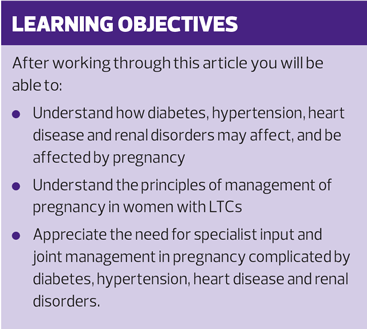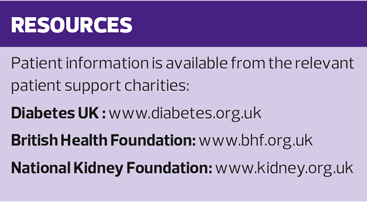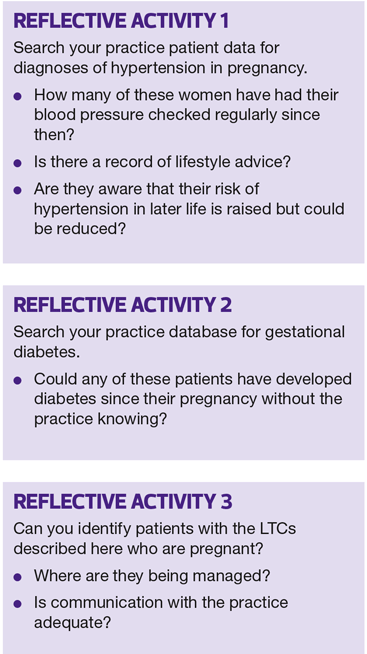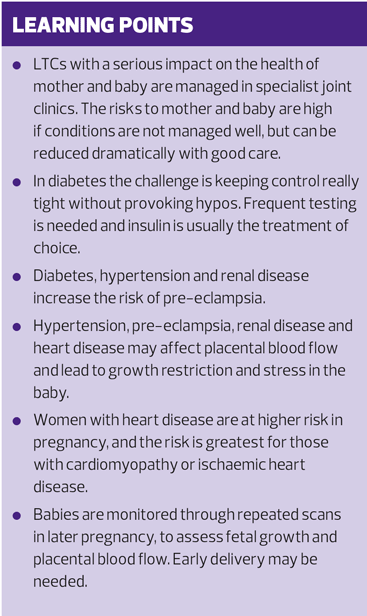Optimising management of long term conditions in pregnancy - Part 1
Mary Lowth
Mary Lowth
MA MB BChir GRCFP PGCMedEd
The combination of pregnancy and long term conditions (LTCs) is a challenge for all health professionals. LTCs can affect both mother and baby during pregnancy, and can themselves be affected by pregnancy. In this series we discuss management of LTCs in pregnancy, starting with diabetes, heart disease, hypertension, and renal disease
Our increasing tendency to specialise can be the enemy of joined-up care, and our wish to be holistic can prevent us from calling on experts. The need to be both holistic and expert is particularly great for pregnant women with LTCs as often no single expert will know best about every aspect of their care – and the stakes are enormous.
Most pregnant patients with the LTCs covered here will attend specialist clinics and the practice may rarely see them. Nevertheless, they may access primary care at any time with related or unrelated conditions, and it is helpful for practice nurses to have an awareness of the broad principles of their management.
DIABETES1
Diabetes affects around 5% of pregnant women in England and Wales. Around four fifths of them have gestational diabetes. The remainder have pre-existing diabetes, with slightly more having type 1 than type 2.
Pre-existing diabetes
Most women with diabetes have successful, healthy pregnancies, but good glucose control during pregnancy is critical.
The highest risks to pregnancy are associated with pre-existing diabetes, and the risks increase with higher blood glucose levels. Glucose (and oral hypoglycaemic agents) cross the placenta, while very little insulin gets across. If blood glucose levels are running high at the time of conception and very early fetal development, then the risk of fetal anomalies is increased. (Women with HbA1C of more than 10% are advised not to get pregnant until it is lower). In later pregnancy high levels make the fetus produce extra insulin and lay down extra fat, leading to a large-for-dates baby.
How does diabetes affect pregnancy?
For the mother with pre-existing diabetes, there is increased risk of hypertension, pre-eclampsia and preterm labour.
The baby is at higher risk of congenital malformations, macrosomia (abnormally high birth weight), shoulder dystocia and birth injury, fetal distress and early postnatal problems. There is an increased risk of miscarriage and stillbirth. Risks directly relate to blood glucose levels during pregnancy.
How does pregnancy affect diabetes?
Pregnancy tends to worsen diabetic control. Pregnancy hormones are diabetogenic and insulin resistance increases as pregnancy advances, so more insulin is needed.
Pregnant women on insulin are more prone to hypoglycaemia (hypos), as the baby will continue to use glucose at the same rate even when the mother’s blood glucose is low. Blood glucose levels can also be volatile for women with morning sickness.
Pregnancy can rapidly worsen the progress of the complications of diabetes, particularly retinopathy and nephropathy. These risks are greater in women who have been diabetic for a long time.
How is diabetes managed in pregnancy2
Pregnant women with pre-existing diabetes are managed by specialist shared care (between the relevant clinical specialist and obstetrician/midwives) clinics. The principles are to achieve the tightest possible control without hypos, to monitor the baby’s growth, to protect against the increased risk of pre-eclampsia, and to deliver the baby slightly before full term.
Healthy diet, regular exercise, smoking cessation and alcohol moderation are hugely beneficial. Women should take the higher dose of folic acid and aspirin 75mg is recommended from 12 weeks to reduce the risk of pre-eclampsia.
Frequent blood glucose testing is needed, before and after meals and before bed. Targets, provided they are achievable without hypos, are:
- Fasting glucose 5.3 mmol/L
- One hour post-prandial 7.8 mmol/L or,
- Two-hour post prandial 6.4 mmol/L.
Women should carry rapid-delivery glucose snacks and/or glucagon.
HbA1c levels are not used to assess control in the second and third trimesters.
Insulin and other medication
Insulin is the treatment of choice, as it offers the best chance of short term, tight, adjustable control, and very little crosses the placenta. Rapid-acting insulin analogues (aspart and lispro) are the first choice, and isophane insulin (NPH insulin) the first choice long-acting insulin. Long-acting insulin analogues or cutaneous insulin pumps are sometimes used. Oral hypoglycaemics are not usually continued, although some women may remain on metformin. Many other oral agents have to be stopped and substituted.
Delivery
Women with pre-existing diabetes are usually advised to have an elective birth between 37+0 weeks and 38+6 weeks. Hospital delivery is recommended as labour causes fluctuating insulin requirements and glucose levels. Most women have an IV line with insulin and glucose infusion and the baby is closely monitored with a scalp electrode (so water birth is not usually possible). However, diabetes does not rule out normal delivery.
High blood glucose increases the baby’s insulin levels, so the baby should feed as soon as possible after birth to avoid hypoglycaemia. The mother may also become hypoglycaemic straight after delivery, as her insulin needs fall rapidly.
Gestational diabetes
Gestational diabetes mellitus (GDM) is diabetes that comes on in pregnancy. As pregnancy increases insulin requirements, some women’s insulin production is unable to keep up. GDM is most common in women who are overweight prior to pregnancy, older mothers and smokers, and those with a family history of diabetes. It recurs in half of women who had it in a previous pregnancy. Most GDM resolves after pregnancy, although there is an increased risk of later developing type 2 diabetes.
The risks to mother and baby are in proportion to the woman’s glucose levels. GDM is not associated with congenital malformations, but macrosomia, preterm labour, shoulder dystocia, birth injury, postnatal problems, and pre-eclampsia are more common.
Women with mild GDM may be controlled by diet and exercise alone, adding metformin if this is not enough. Others need insulin to achieve the tight control needed. Blood glucose targets are as for women with pre-existing diabetes (above). HbA1C is checked at diagnosis. If it is raised it suggests the diabetes may have been there pre-pregnancy.
Women with GDM are offered induction slightly later than those with pre-existing diabetes.
HYPERTENSION3
Hypertension affects about 15% of pregnancies and can lead to the severe hypertensive disorders of pregnancy:
- Pre-eclampsia
- Eclampsia
- HELLP syndrome (Haemolysis, Elevated Liver enzymes and Low Platelet count – a life threatening complication).
It may be pre-existing or be caused by the pregnancy (this usually resolves afterwards, but with increased chance of hypertension later).
- Pre-existing hypertension – detected either pre-pregnancy or before 20 weeks
- Gestational hypertension – detected only after 20 weeks. It includes pre-existing hypertension not previously identified.
Pregnancy tends to worsen existing hypertension, and some normotensive women develop hypertension in pregnancy. The BP rise is partly caused by blood vessels in the placenta, and can affect blood flow to the fetus.
Pregnant women with hypertension have a higher risk of pre-eclampsia, placental abruption, stroke and clotting disorders. Their babies have an increased risk of intrauterine growth restriction, prematurity and intrauterine death. The risk is mainly associated with severe hypertension (greater than 160/110 mmHg). Risks are higher if the hypertension is present before 34 weeks.
Hypertensive disorders in pregnancy are a risk factor for cardiovascular disease in later life. Lifestyle modifications, including control of metabolic factors, and regular BP review are recommended after delivery, to reduce cardiovascular risk in the future.
Management of pre-existing hypertension
The principles of management of hypertension are to control blood pressure, monitor for signs of pre-eclampsia, and monitor the baby’s growth and placental circulation for signs of stress.
Women are usually put on aspirin 75mg daily from the 12th week of pregnancy to reduce the risk of pre-eclampsia. Any existing medication will need to be altered as most drugs usually used for the treatment of hypertension are not recommended or are less effective in pregnancy. Angiotensin-converting enzyme (ACE) inhibitors, angiotensin-II receptor blockers (ARBs), beta blockers and diuretics are switched to labetalol, methyldopa or nifedipine until a few days after delivery.
Urine should be tested regularly for proteinuria, and women need to be made aware of the symptoms of rapidly rising blood pressure, such as headaches, nosebleeds and breathlessness. Fetal growth and placental blood flow are regularly assessed by ultrasound in late pregnancy.
Management is based on keeping the systolic BP below 150mmHg and the diastolic in the range 80-100mmHg. Ambulatory blood pressure monitoring is not recommended in pregnancy as results can be misleading. Women with severe hypertension (160/110 mmHg) are admitted to hospital for close monitoring and bed rest. Early delivery of the baby may be needed.
Gestational hypertension
Gestational hypertension raises warning flags, as it may be a precursor of pre-eclampsia (particularly when it arises before 34 weeks). BP management is as for pre-existing hypertension. The risks to the mother and baby are generally not increased by late gestational hypertension unless pre-eclampsia develops.
CONGENITAL AND ACQUIRED HEART DISEASE4
Women with congenital heart disease need specialist care in pregnancy; their needs and the risks will vary with their specific condition. There is a 50% increase in the work of the heart by the end of the 1st trimester, so a heart with reduced capacity or strength may struggle.
Pregnancy can worsen a heart condition, and this may be a permanent effect.
What kind of heart conditions affect pregnancy?
The heart conditions that could affect pregnancy include:
- Abnormalities of heart valves (e.g. due to rheumatic fever)
- Abnormalities of heart muscle and pumping strength e.g. cardiomyopathy
- Abnormalities of the great vessels
- Abnormalities of heart rhythm – depending on the underlying cause
- ‘Holes’ in the heart (these may be undetected prior to pregnancy)
- Previous heart surgery
- Pulmonary hypertension
- Ischaemic heart disease.
How does pregnancy affect heart disease?
The extra work of pregnancy can worsen many types of heart disease. Heart failure, in which the heart is already struggling to pump normal blood volumes, is worsened by pregnancy.
The risks to the baby are mainly of inheriting the mothers’ condition (if genetic), and of restricted growth. A dramatic worsening of heart disease could make the pregnancy unsustainable, and women with severe heart conditions may be advised against pregnancy.
Women should know what symptoms might indicate serious worsening of their heart condition – particularly chest pain, breathlessness, and excessive fluid retention. Becoming anaemic increases the work of the heart and will make heart conditions worse.
Cardiac disease can, rarely, cause maternal death. This affects about 20 pregnant women per million in the UK: risks are greatest for ischaemic heart disease or heart failure due to cardiomyopathy. Numbers are tending to increase as the age of women having babies rises.
How are women with heart disease managed in pregnancy?
Ideally women with heart disease will have had pre-pregnancy assessment, with an exercise tolerance test, and sometimes echocardiogram and rhythm monitoring. They will be seen regularly throughout their pregnancy in specialist shared care clinics.
RENAL DISEASE5
Chronic kidney disease (CKD) is permanent impairment of the kidneys, due to abnormal structure, or to conditions such as atherosclerosis, SLE, and diabetes. CKD can affect pregnancy, and pregnancy can affect the progression of renal disease, and can itself cause renal impairment.
How common is renal disease in pregnancy?
CKD is divided into stages 1 to 5. Stages 1 and 2 are mild, and affect about 3% of women aged 20-39. Stages 3-5 affect around 1 in 150, but only around 1 in 750 pregnancies.
Around 20% of women who develop pre-eclampsia before 30 weeks have (previously unrecognised) CKD.
How does pregnancy affect renal disease?
The work of the kidneys increases dramatically in pregnancy, and the kidneys of patients with CKD adapt less well to this, so renal function tends to worsen, sometimes permanently.
Pregnancy also causes dilatation of the ureters and renal pelvis, which can lead to an increased risk of urinary tract infections (UTIs) and pyelonephritis. Acute kidney injury can also occur due to pre-eclampsia.
How does renal disease affect pregnancy?
Most pregnant women with CKD have mild renal dysfunction (stages 1-2) and have uneventful pregnancies which do not further harm their kidneys, although there is an increased risk of hypertension and pre-eclampsia.
Women with more severe renal impairment have much lower fertility and are often amenorrheic (though they may still occasionally ovulate). They are at higher risk of permanent worsening of their CKD, and of miscarriage, hypertension, pre-eclampsia and premature labour. Babies are often small for dates. Uncontrolled hypertension, heavy proteinuria, and urinary tract infections increase these risks.
Some renal conditions can be inherited from the mother. Parents will usually have had counselling regarding their risk, and whether abnormalities can be detected prenatally.
Pregnancy is rare in women on renal dialysis. They have low fertility and a high rate of miscarriage. Only 50% of pregnancies are successful. Even so, for mothers with severe CKD not yet on dialysis the outcome for the baby is improved by dialysis.
Fertility often returns rapidly after renal transplant, and for these women the outlook is much better.
Management of renal disease in pregnancy
Woman with mild CKD, in good health and with well-controlled blood pressure usually remain under the joint care of their usual kidney specialists and local obstetric unit. Those with more severe CKD are under the care of very specialist renal and obstetric teams.
Normal CKD management is greatly altered by pregnancy. Estimated glomerular filtration rate (eGFR) is not recommended for monitoring renal function as normal ranges are very different in pregnancy. Glycosuria is common, but overt proteinuria is abnormal.
The principles of management are to monitor renal function, to keep blood pressure below 140/90 mmHg, to monitor for proteinuria, haematuria and infection, and to use low-dose aspirin as prophylaxis against pre-eclampsia. Fetal growth and placental blood flow are monitored at frequent intervals later in pregnancy, and early delivery may be needed if the baby is stressed or growth slows. Women may nevertheless have a normal delivery.
Women with significant proteinuria or nephrotic syndrome are anticoagulated with heparin in pregnancy and the puerperium (warfarin is contraindicated). Other medications must be reviewed. Prednisolone, azathioprine, ciclosporin and tacrolimus can be continued in pregnancy. Cyclophosphamide, mycophenolate mofetil and sirolimus should not be taken during pregnancy, or for some months before conception.
Asymptomatic bacteriuria affects around 1 in 15 pregnant women. About 25% go on to develop pyelonephritis, which can cause intrauterine growth restriction, premature labour and fetal death. It is always treated with antibiotics, and if it recurs, antibiotic prophylaxis may be needed.
CONCLUSION
The chronic diseases covered in this article can all affect mother and baby. Diabetes does so mainly through high circulating levels of blood glucose. Hypertension, heart disease and chronic renal disease can all affect the maternal and placental circulation. These conditions are serious and may be permanently worsened by pregnancy, and joined up care (ideally with pre-pregnancy counselling) is of critical importance to mother and child.
- NEXT TIME: Epilepsy, asthma, musculoskeletal conditions and more. Mental health conditions will be covered in part 3.
REFERENCES
1. Sonagra AD, Biradar SM, Dattatreya K, et al. Normal Pregnancy – A State of Insulin Resistance. Journal of Clinical and Diagnostic Research (JCDR). 2014;8(11):CC01-CC03. doi:10.7860/JCDR/2014/10068.5081.
2. NICE NG3. Diabetes in pregnancy: management from preconception to the postnatal period, February 2015 (updated August 2015)
https://www.nice.org.uk/guidance/ng3
3. NICE QS35. Hypertension in pregnancy, 2013
https://www.nice.org.uk/guidance/qs35/chapter/Introduction
4. RCOG. Cardiac disease and pregnancy: Good Practice no 13, June 2011: https://www.rcog.org.uk/globalassets/documents/guidelines/goodpractice13cardiacdiseaseandpregnancy.pdf
5. Edipidis K. Pregnancy in women with renal disease. Yes or no? Hippokratia 2011; 15(Suppl 1): 8–12. https://www.ncbi.nlm.nih.gov/pmc/articles/PMC3139682/
Related articles
View all Articles



